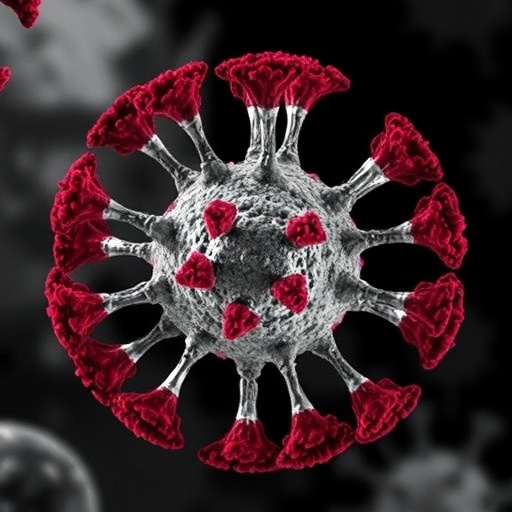In a groundbreaking study poised to reshape our understanding of herpes simplex virus 1 (HSV-1), a team of researchers has unveiled the prefusion structure of the virus’s critical glycoprotein B (gB), elucidating the intricate mechanisms by which it evades immune detection and offering a roadmap for novel neutralization strategies. This work not only provides a high-resolution snapshot of gB before it facilitates viral entry into host cells but also reveals the sophisticated molecular tricks employed by HSV-1 to outmaneuver host defenses, presenting an invaluable target for vaccine and therapeutic design.
HSV-1 is an enveloped virus responsible for a range of diseases, from oral cold sores to potentially life-threatening encephalitis, affecting millions globally. Central to the virus’s ability to infect host cells is gB, a highly conserved viral fusion protein that orchestrates the merger of the viral envelope with host cell membranes, a prerequisite for viral entry. Despite its critical role, the prefusion conformation of gB has long evaded structural characterization, limiting scientists’ capacity to fully understand its function and immune interaction dynamics.
In this seminal investigation, the research team employed advanced cryo-electron microscopy (cryo-EM) techniques to capture and reconstruct the elusive prefusion state of HSV-1 gB at near-atomic resolution. This approach enabled them to visualize the spatial arrangement of gB’s domains sharply before the protein undergoes the dramatic conformational changes necessary for membrane fusion. Previous studies had predominantly characterized postfusion structures, which represent the protein after its functional role in membrane merger, thus missing the critical initial conformational landscape.
Detailed structural analysis revealed that gB adopts a highly metastable configuration in its prefusion form, stabilized by a complex network of intramolecular interactions. Notably, the fusion loops, known for inserting into host membranes during the fusion process, are sequestered in a way that prevents premature exposure, underscoring a finely tuned mechanism of activation. This conformation likely represents a vulnerable window during which neutralizing antibodies can bind and block the fusion event, a potential Achilles’ heel for the virus.
Accompanying their structural insights, the researchers also explored how HSV-1 gB subverts the host immune response. Glycoprotein B is known to be a major target for neutralizing antibodies, yet HSV-1 deftly evades neutralization, allowing persistent infections and periodic reactivation. The study uncovered that gB’s prefusion form exhibits glycan shields and conformational masking that obscure critical epitopes from immune surveillance. This strategic cloaking likely limits the efficacy of antibody binding during natural infection and highlights the challenges in eliciting protective immunity via traditional vaccine approaches.
In addition to structural characterization, the study dissected the binding properties of several potent neutralizing antibodies isolated from infected individuals. These antibodies were found to preferentially recognize and stabilize the prefusion conformation of gB, effectively locking it in a non-functional state and preventing membrane fusion. Such detailed understanding of antibody binding modes provides valuable clues for the design of immunogens capable of eliciting similarly protective responses.
Crucially, the findings have broad implications for antiviral drug development. By defining the molecular landscape of prefusion gB, the team has identified potential small-molecule binding pockets and allosteric sites that could be exploited to design fusion inhibitors. These novel antiviral agents would act by stabilizing gB in its prefusion state or by disrupting the finely balanced conformational shifts necessary for fusion, cutting off the virus at its point of entry.
From a vaccine perspective, the study lays the foundation for next-generation HSV-1 vaccines that focus on presenting the prefusion form of gB as an immunogen. Traditional HSV vaccines have struggled partly due to the dynamic nature of gB and the predominance of postfusion epitopes, which are less effective in eliciting neutralizing antibodies. Stabilizing and displaying the prefusion gB trimer could focus immune responses on functionally relevant and vulnerable sites, enhancing vaccine efficacy and durability.
Moreover, this research sheds light on the evolutionary arms race between HSV-1 and the human immune system. The elegant structural mechanisms of immune evasion documented here reflect sophisticated viral adaptation, highlighting the challenges of mounting an effective immune defense against herpesviruses. Understanding these sophisticated escape strategies also informs broader virology, as similar principles may apply to other class III fusion proteins found across diverse viral families.
The methodology used in this study is a striking example of how integrated structural biology techniques, including cryo-EM, X-ray crystallography, and computational modeling, can be leveraged to tackle previously intractable viral proteins. By synergistically combining these approaches, the authors provided not only static structural data but also dynamic insights into the conformational flexibility and activation pathways of gB, enriching the functional narrative.
Equally important, the study establishes a framework to investigate glycoprotein B homologs in related herpesviruses, such as HSV-2, varicella-zoster virus, and cytomegalovirus. Given the conserved nature of this fusion machinery, the insights gained here could accelerate cross-species antiviral strategies and foster a unified approach to combat herpesvirus infections more broadly.
The intricate dance between viral glycoproteins and host cell membranes is fundamental to viral infectivity, and this study advances our grasp on one of nature’s most complex fusion machineries. By elucidating the prefusion structure and immune evasion tactics of HSV-1 gB, this work marks a transformative leap toward therapeutic innovations that could significantly reduce the global burden of herpes simplex virus infections.
In conclusion, this landmark investigation by Roark, Schaub, Shi, and colleagues propels our understanding of HSV-1 biology into an unprecedented molecular realm. By revealing the architecture of gB before membrane fusion, decoding the immune evasion landscape, and mapping neutralization vulnerabilities, they unlock a new frontier in herpesvirus research. The translational potential of these findings for antiviral drugs and vaccines promises to energize the field and offers hope for more effective interventions against this pervasive pathogen.
Subject of Research: Structural characterization, immune evasion, and neutralization mechanisms of herpes simplex virus 1 glycoprotein B (HSV-1 gB).
Article Title: Prefusion structure, evasion and neutralization of HSV-1 glycoprotein B.
Article References:
Roark, R.S., Schaub, A.J., Shi, W. et al. Prefusion structure, evasion and neutralization of HSV-1 glycoprotein B. Nat Microbiol (2025). https://doi.org/10.1038/s41564-025-02153-x
Image Credits: AI Generated




